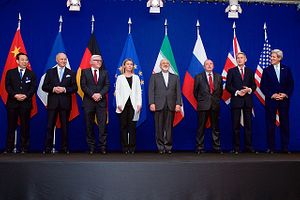After days of hard-fought negotiations in Lausanne, Switzerland, the group of world powers known as the P5+1 — a group comprising the United States, the United Kingdom, France, Germany, Russia, and China — and Iran have come to a framework agreement on a final deal on Iran’s nuclear program. The framework agreement, which was announced at roughly 7 p.m. local time on April 2, 2015, outlines a set of understandings between both sides on a serious of contentious issues related to Iran’s enrichment capabilities, nuclear facilities, international inspections, transparency standards, sanctions, reprocessing, and phasing. A fact sheet summarizing the terms of the framework agreement can be accessed here.
The following are the primary highlights of the framework deal:
- Iran will reduce its centrifuge capacity by roughly two-thirds, operating roughly 6,000 IR-1 (first generation) centrifuges. Iran’s all-time maximum centrifuge capacity was roughly 19,000.
- For the next 15 years, Iran will not enrich uranium over 3.67 percent — considered a low enrichment grade that is far from weapons-grade. Additionally, Iran will lower its current stockpile of LEU from 10,000 to 300 kilograms.
- Relevant to hawkish critics of the deal, the framework agreement document notes that for the first ten years of the deal, Iran’s estimated “breakout” time (the time it would take Iran to sprint to an operational nuclear weapon) is one year, up from a current estimate of two to three months.
- Critically, Iran will carry out all of its enrichment activity at a single site (Natanz) and only with the use of IR-1 centrifuges. Iran will, however, be able to continue research and development of advanced centrifuge technology. Fordow will be converted to a research and development facility for peaceful purposes, and Arak, Iran’s plutonium reactor, will be dismantled entirely and replaced with a new facility which will be “based on a design that is agreed to by the P5+1.”
- The International Atomic Energy Agency will have regular access to inspect all Iranian nuclear facilities, including access to Iran’s supply chain for nuclear materials and technologies.
- Iran will not reprocess any spent fuel. The document notes an indefinite commitment from Iran on this issue. Iran is additionally barred from constructing a heavy water reactor for 15 years.
In exchange for these wide-ranging concessions on its nuclear program, Iran will receive sanctions relief from the European Union and the United States after the IAEA confirms successful implementation of a final deal. There was some confusion after Iranian Foreign Minister Javad Zarif implied that Iran would be sanctions-free as a result of this deal. During his speech after the announcement of the framework deal, U.S. President Barack Obama reminded Iran that U.S. sanctions that were put in place after the Iranian Revolution for Iran’s support of terrorism, use of proxies, and violations of human rights will remain in place.
Negotiators from the P5+1 and Iran will continue to work toward the actual comprehensive agreement, which is expected at the end of June. Already, however, reports are emerging from Tehran that Iranians are celebrating the framework agreement in the streets. In an unprecedented move, Obama’s remarks (viewable here) on the framework agreement were broadcast live in Iran.
Today’s agreement represents the most significant diplomatic step in the long-standing negotiations on Iran’s nuclear program since the November 2013 signing of the interim agreement between the P5+1 and Iran (known as the Joint Plan of Action). In that agreement, the P5+1 granted Iran limited sanctions relief in specific areas for concessions on nuclear development.
The successful conclusion of a deal between Iran and world powers on the former’s nuclear program will have far-ranging geopolitical impacts, not only in Iran’s immediate region but for the whole world. Israel, Saudi Arabia, and other states skeptical of Iran’s assurances that its nuclear program is intended for civilian use will likely react negatively to the framework agreement. To Iran’s east, Afghanistan, India, China, and Southeast Asian states will welcome the deal and the ensuing opportunities for normal, unencumbered commerce with Iran.

































